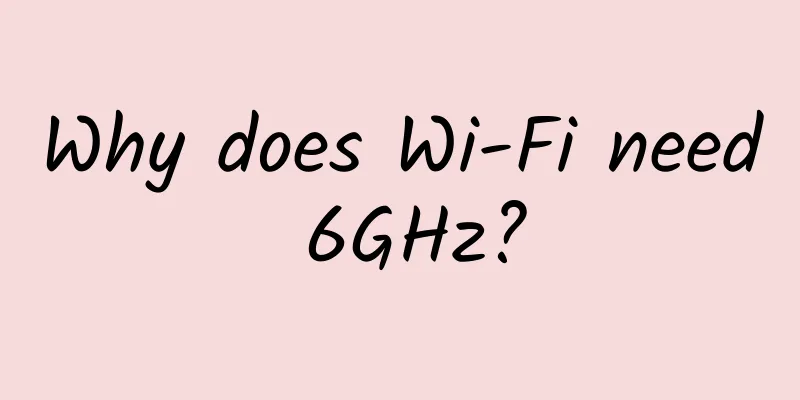Why does Wi-Fi need 6GHz?

|
As the most commonly used Internet access technology, Wi-Fi is closely related to the lives of each of us. Especially in the past two years, due to the epidemic, more and more social activities have shifted from offline to online, and Wi-Fi has played a huge role in this, significantly reducing the impact of the epidemic on society and the economy. According to data provided by Cisco Networks (as shown in Figure 1), in 2021, 50% of global Internet traffic will come from Wi-Fi. Figure 1. Access technology share of global data traffic in 2021 (data from Cisco Networks) Over the past 20 years, Wi-Fi has relied on only two frequency bands, 2.4 GHz and 5 GHz (a total of more than 600 MHz of spectrum), to meet the ever-growing network demands. In the previous article (link), we talked about some new technologies in Wi-Fi 6. These technologies can help alleviate the problem of network congestion. However, even though wireless engineers can use a variety of black technologies to expand network capacity, the rapid growth in the number of wireless devices in recent years and the increasing speed requirements brought by applications have ultimately caused spectrum to become a bottleneck for network capacity. Currently, the 2.4GHz and 5GHz frequency bands used by Wi-Fi are already very crowded, which is reflected in the user experience, that is, the increase in network latency, the decrease in user speed, and the increasing interference between Wi-Fi routers. To meet this challenge, the Wi-Fi industry actively promoted the development of Wi-Fi 6E shortly after the launch of Wi-Fi 6. Wi-Fi 6E uses the core technology of the current Wi-Fi 6 and expands the network capacity by extending the operating frequency band of Wi-Fi 6 to 6GHz (5925-7125MHz). As shown in Figure 2, the newly added 1200MHz has doubled the spectrum resources for Wi-Fi compared to the past. Figure 2 Wi-Fi frequency band development history The 6 GHz spectrum can bring a qualitative leap in Wi-Fi performance. As shown in Figure 3, 6 GHz doubles the number of Wi-Fi channels. Figure 3 Number of 2.4, 5, and 6 GHz Wi-Fi channels Taking the most commonly used 40MHz channel as an example, 5GHz can provide 4 normal channels and 8 DFS channels. (Note: The function of DFS channels is to protect the frequencies used by radars from interference. When a Wi-Fi device detects that a radar is using this frequency band, the Wi-Fi will automatically avoid this channel). On 6GHz, there are up to 29 40MHz channels that are not restricted by DFS for Wi-Fi devices to choose from. Why do we need so many channels?To answer this question, we need to look at each node of the network as a whole. From mobile phones and computers to wireless routers and subsequent fiber optic networks, if any node has a bottleneck, the performance of the network cannot be improved. In the past, when fiber optic cables were 10M to 100M, the bottleneck of network speed was often in the fiber optic network itself. Simply increasing the speed of Wi-Fi does not make much sense for the overall performance of the network. Today, with the advancement of the national dual-gigabit infrastructure project, more and more households can use optical networks with gigabit speeds, and the speed of enterprise fiber optic networks can reach 10Gb. Fiber optic technology is constantly being updated. Fiber optic technology above 50Gbps appeared in the development blueprint of the International Telecommunication Union (ITU) as early as 2018, and commercial products are expected to appear in the near future. Figure 4 ITU optical fiber technology development blueprint In the past, Wi-Fi devices mainly used 20MHz and 40MHz bandwidths. Our mobile phones and Pads are usually equipped with two Wi-Fi antennas to support MIMO. According to the data rate calculation table provided by Aruba Network in Figure 5, the theoretical maximum rate of a Wi-Fi device using 2-way MIMO and 64QAM modulation in a 40MHz bandwidth can only reach about 344Mbps. (Note: Higher-order modulation requires an extremely good wireless channel signal-to-noise ratio, which is difficult to meet in daily life) Figure 5 Theoretical maximum data rate of a single channel under Wi-Fi 6 When users already have gigabit fiber, such Wi-Fi performance becomes a bottleneck in the network. At this time, it makes sense to increase the Wi-Fi rate. By increasing the bandwidth to 80MHz, the maximum rate can exceed 700Mbps, and the 160MHz bandwidth can fully meet the needs of Gigabit fiber. The trend of increasing bandwidth can also be verified by analyzing the use of routers by users. According to the analysis of Cisco and Aruba on their users, 80MHz bandwidth is gradually becoming the default option for homes and businesses when configuring Wi-Fi networks. At this point, you may have questions. Didn’t the previous article mention that OFDMA, high-order modulation, and more MIMO technologies can improve the rate and network capacity? Why do we need to increase channel resources? The reason is actually very simple: there is no free lunch in the world. Although MIMO can provide multiple channels to increase data rates, the cost is that the additional channels require corresponding transceiver channels, which increases the power consumption of Wi-Fi devices. Second, the introduction of high-order modulation and more channel MIMO means that the RF receiver has higher requirements for the signal-to-noise ratio of the wireless channel, which reduces the cell coverage and the anti-interference level of the equipment. The essence of OFDMA is how to distribute the pie to users more effectively, not how to make the pie bigger. Therefore, the most direct and effective way to increase capacity is to widen the bandwidth and increase spectrum resources. You may still have questions. Doesn’t Wi-Fi 6 on 5GHz also support 80 and 160MHz bandwidth? Why do we need Wi-Fi 6E? To answer this question, we need to discuss it from the perspective of multi-router deployment in the network. The current industry gold standard for dense Wi-Fi network deployment is the 7-channel reuse scheme, which is the best optimization point to balance spectrum efficiency and inter-cell interference. The so-called 7-channel reuse scheme means that the 6 adjacent routers around a wireless router all use different Wi-Fi channels. Take the Wi-Fi deployment in the first-floor office space in Figure 6 as an example. Figure 6 7-channel Wi-Fi cell deployment solution In a network that uses the 7-channel reuse scheme, Wi-Fi cells on the same frequency can be separated from each other by two cells on different frequencies. Due to the long distance, the risk of co-frequency interference between cells is very small. In the past, this deployment put no pressure on the spectrum based on the use of 40MHz channels. However, when users upgrade the channel to 80MHz bandwidth, the current 5GHz spectrum will not be enough. This is where Wi-Fi 6E comes in handy. From the channel diagram above, we can see that 6GHz has up to 14 80MHz channels, which can fully meet the requirements. Even if users upgrade to 160MHz bandwidth in the future, 6GHz can still provide 7 channels to meet network deployment. Current global development of Wi-Fi 6EWi-Fi 6E devices generally support the entire 6 GHz, but in terms of the specific usable frequency range, equipment manufacturers need to meet the frequency band requirements of each country. There are two main directions for the allocation of 6GHz Wi-Fi spectrum internationally. The first is a one-step approach based on ITU Region 2 (Americas), which opens the entire 1.2GHz spectrum (5925-7125MHz) to Wi-Fi use. The second method is a gradual approach, first opening up 500MHz in the lower 6GHz band (5925-6425MHz) for Wi-Fi use, and then opening up 500MHz in the upper 6GHz band (5925-6425MHz). We will continue to take a wait-and-see attitude towards the planning of (6425-7125MHz). Regions that hold this strategy mainly include the European Union, Australia, Japan and other countries. One of the main reasons for this is that an important topic under WRC-23 Agenda 1.2 has an impact on the spectrum allocation in these countries and regions. In this issue, the 6425-7125MHz frequency band may be identified as a mobile communication frequency band in some regions for use in future 5G or even 6G. my country is also one of the active supporters of this issue. Since 2021, there have been a large number of terminals and network devices that support Wi-Fi 6E. Currently, the entire Wi-Fi 6E ecosystem is developing very well, and it is expected that more mainstream devices will start to support Wi-Fi 6E this year. Figure 8 Wi-Fi 6E Ecosystem Will China approve the use of Wi-Fi 6E?On the issue of 6GHz, the attitude of our Ministry of Industry and Information Technology before and after WRC-19 has always been to support allocating the entire 6GHz to 5G and future 6G mobile communications. Wi-Fi 6E has not received much attention in China. This has a lot to do with our country's 5G industrial policy and the amount of available spectrum in the current 5G mid-band. Judging from the data released by Qualcomm below, China's 5G spectrum in the mid-band is only 100MHz at 2.6GHz and 300MHz at 3.5GHz, which also includes 3.3-3.4GHz specifically allocated for indoor 5G use. In general, the total amount of mid-band spectrum is less than that in the European Union, North America, Japan and South Korea. Figure 9 Global 5G spectrum allocation (data from Qualcomm) However, starting last year, the Hong Kong SAR government took the lead in planning the use of Wi-Fi 6E in Hong Kong. In the public opinion solicitation issued by the SAR government last year, the impact of the current Wi-Fi network congestion on businesses and individuals was mentioned. After several months of soliciting opinions and discussions, in the final decision document released by the Hong Kong Communications Authority in April this year, Hong Kong adopted a step-by-step approach, that is, to follow the example of the European Union and first open the lower 500MHz of 6GHz for Wi-Fi use. For the upper 700MHz, Hong Kong will focus on the discussion of the topic 1.2 of WRC-23 agenda. I have attached the policy document of the Communications Administration in the references, and those who are interested can study it on their own. Figure 10 Hong Kong Communications Authority Wi-Fi 6E Public Opinion Collection Form Hong Kong's spectrum policy gives people a glimmer of hope for Wi-Fi 6E in mainland China. In terms of the past C-band and millimeter wave 5G planning, Hong Kong is basically consistent with the mainland, but the policy release time is often one step ahead of the mainland. If this rule is established, the Ministry of Industry and Information Technology may consider the needs of Wi-Fi in the future when planning the 6GHz spectrum. In fact, the Wi-Fi network congestion problem is not only in Hong Kong, but also in large and medium-sized cities in the Mainland. In the future, if we want to improve the performance of enterprise and home networks, relying solely on 5G is far from enough, whether in terms of enterprise costs, device ecology, or the load capacity of the three major operators. In addition, even though we cannot compare with companies like ZTE, Huawei and China Mobile that have a significant influence in the international mobile communications industry, my country also has large companies in the Wi-Fi industry such as H3C, FiberHome and TP-link. Even the enterprise network divisions of ZTE and Huawei themselves are important partners in the Wi-Fi ecosystem. If 6GHz is fully allocated to mobile communications, it will be a major blow to companies whose main business is Wi-Fi products and services. In particular, whether Wi-Fi 7 can be developed in China in the future will largely depend on whether there are sufficient spectrum resources. Judging from the history of technological development at home and abroad, technological updates are often unpredictable. Led by government policies, betting everything on a certain technology often involves the risk of misjudgment. Industrial policies are usually not as effective as market policies in terms of long-term market vitality and international competitiveness of products. Allowing enterprises to decide the future direction of technological development through fair market competition will make capital allocation more reasonable, resource allocation more efficient, and enable enterprises to have stronger vitality. The Future of Wi-FiWi-Fi technology is constantly being updated. Soon after Wi-Fi 6 was released in 2019, the 802.11 working group began research on the next generation of Wi-Fi technology, Wi-Fi 7. The academic name of Wi-Fi 7 is 802.11be, which uses exactly the same spectrum resources as the current Wi-Fi 6E. Currently, the standardization work of Wi-Fi 7 is still in full swing, and the first release was finalized at the beginning of this year. The complete standard work will not be finalized until after 2024. Certified Wi-Fi 7 devices will not be popularized in the market until 2025. I will focus on introducing the key technologies of Wi-Fi 7 in the next article. Figure 11 Timeline of Wi-Fi 7 The author of this article, Dr. Xin Tang, is currently the technical director of Spectrum Lab. References[1] Aruba Networks white paper — Technical Guide to Wi-Fi 6e and the 6 GHz band. [2] Wi-Fi Alliance – Countries Enabling Wi-Fi 6E. [3] Qualcomm, 5G spectrum innovation and global update. [3] Communications Authority of Hong Kong - Establishment of a Class Licence to Regulate the Use and Business Activities of 6 GHz Devices for Wireless Local Area Networks and Variation of the Class Licence for the Provision of Public Wireless Local Area Network Services [4] Khorov, E., Levitsky, I., & Akyildiz, IF (2020). Current status and directions of IEEE 802.11be, the future Wi-Fi 7. |
<<: What is 6G and the future of wireless?
>>: The third anniversary of 5G license issuance: "Three-generation life" has brought prosperity
Recommend
How to build a secure HTTPS site step by step
[[261093]] Usually a web site opens HTTPS. Taking...
What does service governance govern? 10 pictures tell you the answer
[[392916]] This article is reprinted from the WeC...
Advantages of 5G technology in future US military networks
The article shows that the United States is incre...
Miao Wei: 5G temporary licenses will be issued this year and 5G terminals will be launched in the second half of the year
On January 10, Miao Wei, Minister of Industry and...
RAKsmart: Dedicated servers from $20/first month, high-security servers from $79/month, cluster servers/1~40G high-bandwidth servers, etc.
RAKsmart launched the "New Year's Big Di...
Megalayer: VPS hosting 50% off, 189 yuan/year, cloud server/high-defense server 60% off, Hong Kong/Singapore/US/Philippines data centers
Megalayer has released the 2024 New Year's Da...
Industrial Internet communication protocol types, functions and connection methods
With the advent of Industry 4.0, the Industrial I...
Why do we need RPC when we have HTTP?
This article briefly introduces the two forms of ...
What are the big opportunities after NB-IOT in the field of Internet of Things?
With the freezing of the R3 core standard of NB-I...
Do you know how to use a switch? The correct way to connect a switch
In the era of popular Internet, many families hav...
Is IIoT edge computing ready?
Edge computing, a powerful technology that has be...
Yike Cloud: 20% off on all VPS hosts, US CN2 GIA/AS9929/AS4837/Hong Kong CN2, etc. starting from 22 yuan/month
OneTechCloud is a Chinese hosting company founded...
Visiting famous IT companies | Xu Hongcan, Chairman of Nantian Information: Focusing on the main business and moving forward against the wind, adhering to long-termism in the face of uncertainty
A sudden epidemic has affected the development of...
LiteServer New Year Promotion: 2GB RAM NVMe hard disk package from €3/month, 512G large hard disk VPS from €3/month
LiteServer is a foreign hosting company founded i...
Shanghai Pudong issued the country's first "blockchain construction standard" in the government sector
Recently, the Pudong New Area's "Governm...



![[6.18] LOCVPS 20% off, top up 100 get 10 yuan / top up 5000 get 618 yuan, 4G memory package starts from 52 yuan/month](/upload/images/67cabe8b75a0f.webp)





